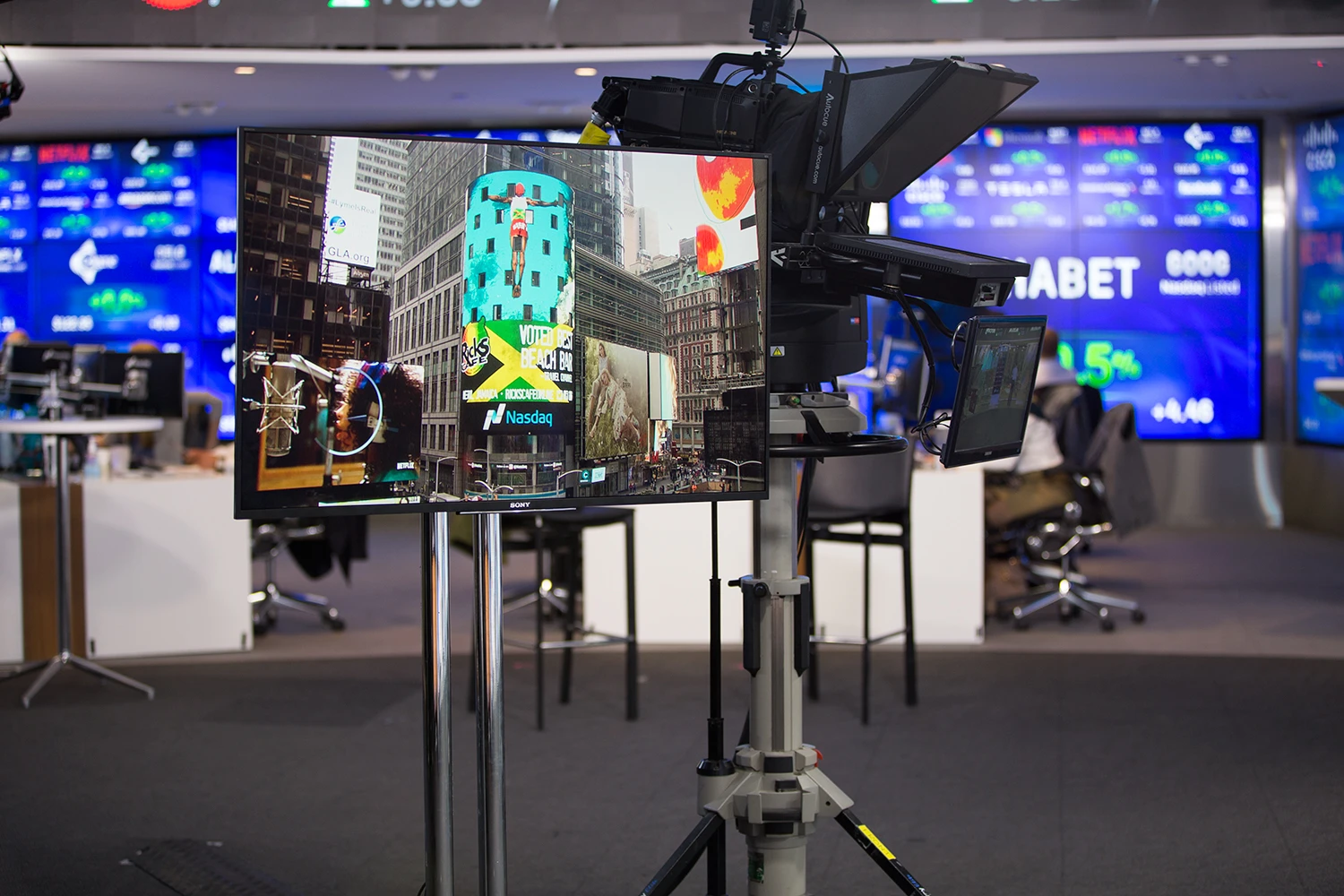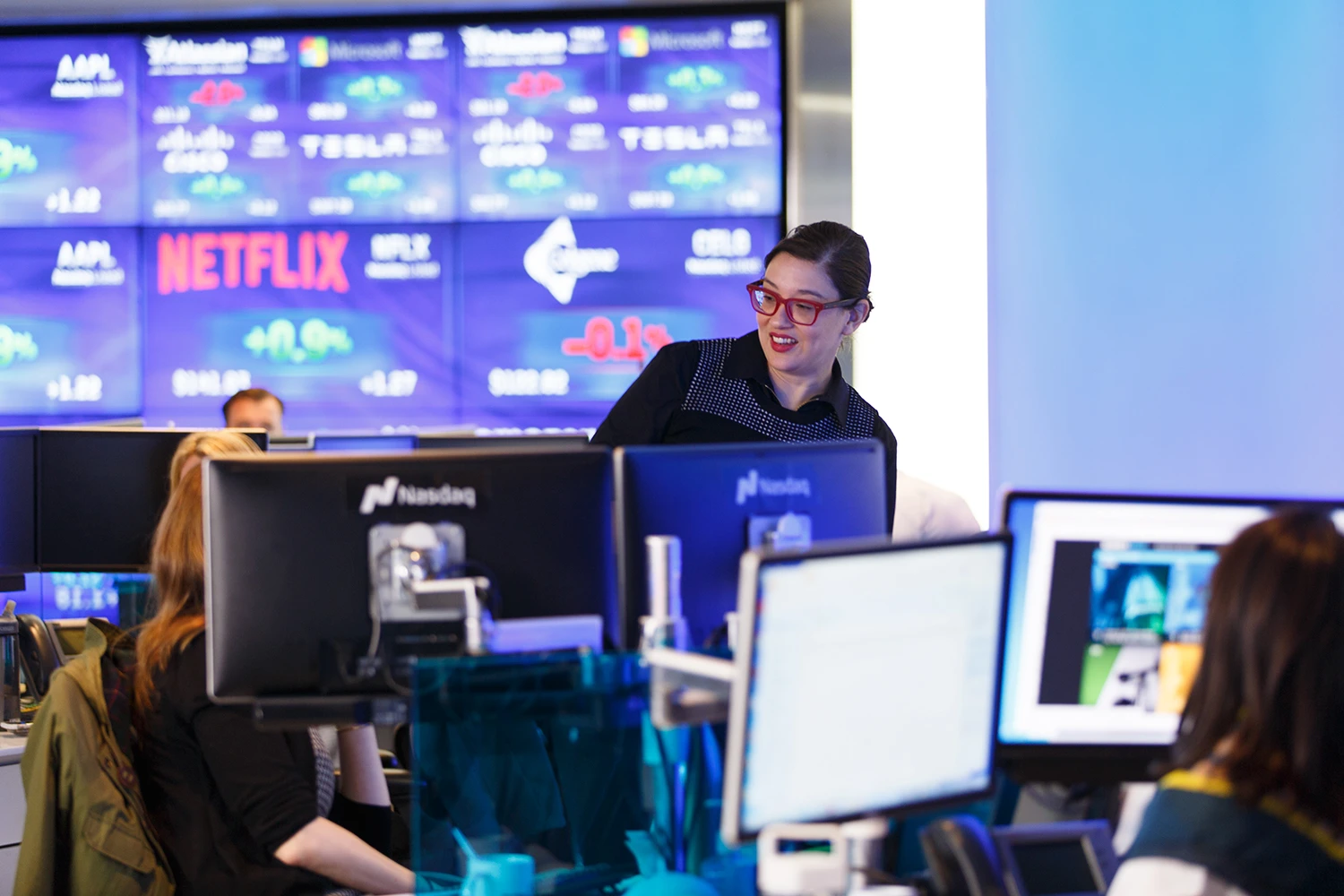It’s Friday morning at Nasdaq headquarters, and that means demo time. Adena Friedman, a Nasdaq veteran who became CEO of the exchange in January, breezes into a 30th-floor conference room overlooking the neon thrum of Times Square. “These are always the fun meetings,” she says, taking a seat at the center of the table alongside her CTO and some of his top developers.
Fun—and mission-critical. Nasdaq was a technology trailblazer in the 1970s, when it became the world’s first electronic stock market. Over time, the company developed a reputation as the listing destination for Silicon Valley stars like Apple and Oracle, and a valuable provider of market data to boot. But the forces that catapulted Nasdaq to success are no longer a competitive advantage: IPOs (and listings) are in decline overall, arch-rival New York Stock Exchange has been landing many of the top tech IPOs, and electronic trading is now de rigueur. Friedman, the first woman to run a U.S.-based stock exchange, will have to get creative and look outside of Nasdaq’s core business to deliver growth.
Friday product demos, reflecting work in progress at Nasdaq’s innovation lab, are a first step toward that goal. Friedman settles back in her chair as a software developer turns on an Alexa device and begins to play the part of hypothetical customer, in this case an investment relations officer at Berkshire Hathaway.
“Sell-side commentary about Berkshire Hathaway has been positive,” Alexa says in response to his first question, her dispassionate alto filling the room. She goes on to describe Berkshire’s largest investors (“Fidelity Management is the largest holder with a 3.7% position”), read from an investor report, and email a meeting invitation before signing off with a flash of blue: “Goodbye. Nasdaq is always here to help you.”

With just a few minutes of Friedman’s time remaining, a developer who has been experimenting with augmented reality slides a Microsoft HoloLens over his glasses. The lights dim, the blinds lower, and the room quiets. A copy of the HoloLens field of vision has been projected on a screen for all to see; as Nasdaq’s trading data comes into 3D relief, Friedman’s face briefly appears in the bottom corner. Her eyes are locked on the data—blobs of pink, blue, yellow, and green—as the developer playing data scientist zooms in and rotates the plot with choreographed gestures.
Friedman delivers a brisk summary when the lights turn back on. “So it’s just the beginning of time for us on this,” she says as heads nod. “We’re going to continue to work on it. This is obviously terrific.” A dozen pairs of tense shoulders relax. Friedman stands and then darts a final raised eyebrow toward an attendee taking advantage of Nasdaq’s evolving dress code. “I like the jeans,” she says, before disappearing out the door.
If Friedman could have just one futuristic technology in her own life, it would be a Star Trek–style transporter. For almost the entirety of her nearly 20-year career at Nasdaq, she has lived outside Washington, D.C., with her husband and two sons, while commuting to New York for work each week. Perhaps that’s the reason she has sometimes been absent from the “most powerful women on Wall Street” lists that the industry rags like to publish.
But make no mistake, Friedman has earned a spot near the top. She rose at Nasdaq from MBA intern to C-suite executive over the course of two decades, before leaving in 2011 to take the Carlyle Group public as the private equity firm’s CFO. When she rejoined Nasdaq in 2014, then-CEO Bob Greifeld, now chairman of the board, began laying the groundwork for her promotion. She stepped into the role of CEO on January 1.
“If someone gives you an opportunity, you better maximize it so that he wants to give you the next one,” Friedman says, reflecting back on her early years at Nasdaq. A senior manager was impressed by her work ethic, and began giving her more and more responsibility. “I was always first in, last out, but not inefficiently,” she says. That first year she found herself at the office on her birthday, helping manage an emergency as the clock inched toward 9 p.m. “It was one of those things where you did what you needed to do. I had that attitude of, ‘I’m early in my career. I want them to know that I’m here for them no matter what.'”

“Those middle years are the ones that every CEO should be really, really focused on,” she says. “You tend to have a little more turnover in general in those middle years, and then put on top of that the fact that women have a lot more responsibilities once they have kids. It just adds to that pressure and stress, and at the same time they may not see the advancement opportunities. They start to say, ‘Is this what I want to be doing?'”
At Nasdaq, Friedman wants to make sure that the answer is “yes.” Her first addition to Nasdaq’s board of directors was a woman—telecom executive Melissa Arnoldi, who is president of technology development at AT&T. Friedman is also proud of the percentage of Nasdaq’s senior vice presidents who are women—21% (by way of comparison, 16% of partners at Goldman Sachs are women, the bank’s highest-ever rate).
After working her own way up the career ladder, Friedman found herself on the defensive less than a month into her tenure as CEO. On January 30, Snap Inc. announced that it would IPO on NYSE, a further blow to Nasdaq’s reputation as the listing venue of choice for technology innovators (in recent years it also lost bids for Box, Fitbit, LinkedIn, Shopify, Twitter, and Yelp). “Bizarro: It’s an upside-down world where Snap is listing on the NYSE and Hamilton Lane is listing on the Nasdaq,” deal reporter Dan Primack wrote in his popular newsletter. Even more embarrassing, Nasdaq had seemingly used every weapon in its arsenal to charm Snap CEO Evan Spiegel, going so far as to film the Manhattan skyline using Snap’s video-streaming Spectacles—from a helicopter.
“We compete for every listing,” Friedman says. “We’d like to win them all, but we don’t.” Snap was a “headline-grabber,” she says, with little resemblance to the B2B technology companies, like newly public Nutanix, that have been Nasdaq’s bread and butter. Last year, as in years past, the company had a higher IPO win-rate than the NYSE.
All the same, IPO pickings are slim in our unicorn era—and wins are all the more important as a result. In the U.S. in 2016, there were just 16 tech IPOs and 105 overall (20 years ago, the total was seven times that number). Meanwhile, private giants like Airbnb and Uber continue to attract billions of investment dollars. On average, they are staying private for at least twice as long as startups did 15 years ago.
New listings are central to Nasdaq’s public brand, but in reality they are just one piece of the company’s operations. The $11.7 billion organization Friedman inherited is increasingly resilient, thanks to smart efforts to expand into related products and services. Nasdaq not only owns and operates exchanges in the U.S. and Europe, it also uses its technology to power over 90 independent marketplaces in 50 countries. In addition, the company sells market data to Wall Street, and corporate services like investor relations to over 18,000 clients (if Nasdaq’s Alexa skill ever goes to market, they would be its target).
It’s all part of a mad dash to stake out territory amid macro shifts in the public markets. Passive investing is newly dominant, attracting $1.5 trillion in assets since 2013 ($800 billion fled active investments during that same time frame). In parallel, the number of publicly listed companies has declined by nearly half since the mid-1990s. When Friedman joined Nasdaq in 1993, there were 6,329 firms listed on U.S. exchanges. Today there are around 3,700.

So far Nasdaq has had some initial success applying its strengths to adjacent opportunities and partnering when necessary. Its surveillance solution, for instance, has become essential for many Wall Street institutions, which have seen their compliance needs (and budgets) balloon since the financial crisis. They now spend millions to detect illegal behavior, like spoofing—i.e., faking interest in a trade in order to manipulate prices. Nasdaq has developed its own surveillance solution, which mines trading data for insights, and last year invested in a startup called Digital Reasoning, which specializes in monitoring unstructured data from email, social media, and other communications.
With an eye toward the longer-term, Nasdaq has also been experimenting with blockchain, the much-hyped distributed ledger technology that provides the infrastructure for bitcoin. Blockchain is most commonly associated with cryptocurrencies, but its potential applications are far more sweeping. Most notably for Nasdaq, blockchain can serve as a system of accounts for private market transactions. Ownership records at a unicorn like Airbnb, for example, can get unwieldy, as the company adds additional investors and some early investors sell their stakes. Today, those records exist in some combination of paper certificates and Excel. With blockchain, owners would have an immutable central record of their transactions.
“[Unicorns] need all the same services as a GE would need from an exchange, but without a publicly traded stock,” says Rob Jaeger, a partner at Wescott Capital. “It’s an experiment, and I think it should be called as such.” But when it comes to innovating, he says, “Nasdaq is the real deal. It’s not a ‘check the box’ exercise.”
Of course, there is a fundamental tension in making it easier for unicorns to keep raising venture capital dollars—a public company is far more profitable to Nasdaq than a private one. There is also a question of scale; private market trading volume pales in comparison to trading volume in the public arena. Even on a 10-year horizon, Nasdaq may have to look even farther afield to deliver growth.
Solving that challenge is the responsibility of silver-haired CTO Brad Peterson, who also leads the innovation lab. Peterson is the type of manager who seems content to let his team own the spotlight, while drily contributing the occasional one-liner or piece of context from the sidelines. He arrived at Nasdaq after spending five years at Ebay, where as chief information officer he mastered the ins and outs of online auctions. At an abstracted level, auctions and exchanges are similarly Nasdaq’s core expertise.
“We’ve broadened our view of what could be our opportunity, and it’s significantly bigger than just financial services,” Peterson says. Wall Street trading has gone “machine to machine,” and operations in other industries will soon follow. That creates a window of opportunity for someone like Nasdaq, with experience managing markets (what Silicon Valley would call a “platform”). “We have a CEO who’s looking beyond the current landscape, plus we have the tech capability.”
As a proof point, Peterson cites Nasdaq’s partnership with the New York Interactive Advertising Exchange (NYIAX), which launched this past March. NYIAX facilitates the buying and selling of digital ads weeks or months in advance of their placement, using Nasdaq’s blockchain technology. While NYIAX is just getting started—its initial pilot included 10 publishers—the exchange’s founding team believes that other media organizations will follow, drawn by the lure of greater transparency and data security.

Nasdaq can be nimble and partner with startups because the company modernized its systems and transitioned operations to the cloud under the direction of Friedman’s predecessor Bob Greifeld. “We do not have mainframes, like a lot of the big banks. We have a very elegant architecture,” Peterson says. But the company’s overall vision for that modern technology, before the CEO changeover, was more limited: “Let’s stick to our knitting.” Friedman, Peterson says, has the “confidence to try things, and really focus on the customer.”
Friedman’s confidence runs deep. She seems entirely at ease amid Wall Street’s big-shouldered suit-and-ties, with arrow straight posture and a black belt in taekwondo (an achievement featured again and again in coverage of her career, which perhaps says more about financial services and its power-pose culture than it does about Friedman).
But taekwondo is a relatively recent hobby, ranking far below her lifelong love of droids, light sabers, and intergalactic travel. Friedman was a 10-year-old kid growing up in Baltimore when the original Star Wars hit theaters; she was soon hooked alongside her older brother. Her father, in turn, introduced her to Star Trek, which became an equal obsession. Among friends, her sci-fi geek status is well-known: Many assumed her son Luke had been named after a certain Skywalker (he was not). Luke and Logan are now full-grown, but the Friedman family living room still contains a life-size model of Darth Vader, purchased on Ebay.
What attracts her to sci-fi is less the fantasy, and more the sense of real-world possibility. “One of the things I liked about the movie Minority Report was they used a lot of futurists as consultants to really try to understand what the world really would be like in 50 years,” she says, before making an expert CEO transition to her business agenda. “I like the idea of using all this science and technology to allow for our clients to have a deeper insight into the market. Now, whether or not someone is going to put one of those [HoloLens] headsets on and work through the day, I’m not so sure.”
But if Wall Street does move in that direction, the Nasdaq that Friedman is building will be ready to help make it so.
Recognize your brand’s excellence by applying to this year’s Brands That Matter Awards before the early-rate deadline, May 3.
